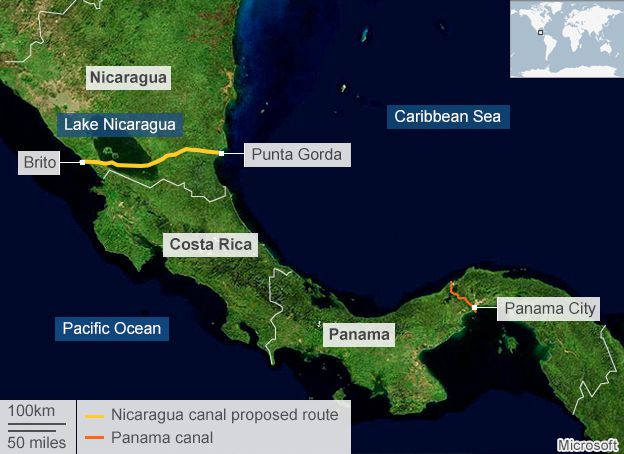Back in the early 1900s, the United States seriously considered using the Central American country of Nicaragua for the construction of a canal—a groundbreaking development, connecting the Atlantic and the Pacific oceans. After several studies done in the country, and realizing that Nicaragua was not economically prepared for a project of that magnitude, they decided that Panama was to be the location for the American built canal. A century later, it appears that the creation of the Nicaragua grand canal could happen. Nicaragua is currently one of the poorest countries in the Western Hemisphere, as it has been heavily affected by dictatorships, civil war, and natural disasters. After the governmental revolution of the 1980s, Nicaragua became a society undergoing progress.1 The country’s unconstitutional president, Daniel Ortega Saavedra, is now hoping to launch one of the world’s most ambitious infrastructure schemes—a canal project to rival the Panama Canal.2 His proposal promises to release Nicaragua from the terrible effects of poverty. Although the project sounds promising, its uncertainty has caused incredible amounts of controversy and chaos throughout the country. Without a doubt, the creation of the Interoceanic canal through Nicaragua would deeply aggravate the nation’s environment, economy, and sovereignty.

Before examining the complexity of this billion-dollar project, it is important to understand Nicaragua’s historical context. Nicaragua is the largest republic of Central America, having a land area about equal to that of the state of New York.3 This Central American country is not only known for its ecological wonders, but also for the countless tragedies it has been through. In the 1960s, Nicaragua was the leading economic power of central America. Nevertheless, after a terrible 6.2 magnitude earthquake in 1972, and a bloody civil war, Nicaragua never truly recovered economically. Currently, the Sandinista Regime, headed by Daniel Ortega, governs the country. For the past eight years, the administration has sought distinct investment opportunities for the Nicaraguan economy to flourish. The creation of a multi-million dollar water park, a new airport, and a colossal interoceanic canal, are some of the proposals leading Ortega’s governmental plans. In early 2013, Ortega made headlines across the world by announcing that a Chinese rookie firm (HKND) would build a $40 billion interoceanic canal in Nicaragua that would compete with the Panama Canal and turn Nicaragua from a poverty-stricken nation into a global shipping power overnight.4 If built, the Grand Interoceanic Canal would be more than twice the length of the Panama Canal. But it would be the perfect size for the next generation mega-container ships.

What is the HKND? More importantly, who is the so-called main investor? In 2014, Ortega pushed a law through the Nicaraguan government, with almost no debate, that gave total control of the construction of the interoceanic canal to a mysterious Chinese company — The Hong Kong Nicaragua Canal Development Investment Co.5 The HKND is headed by Wang Jing, a Chinese telecommunications magnate. The decree gave Wang’s company an exclusive concession to build an interoceanic canal and seven related projects, including ports, airports, and tourism resorts.6 The almost frightening fact, however, is that neither the HKND nor Jing have had any prior experience dealing with a project of this magnitude. The enigmatic HKND group doesn’t appear to have any direct ties to the Chinese government, nor any international experience managing infrastructure projects.7 Amazingly, there is not much more information concerning the HKND. The only information available comes from the limited governmental publications Ortega’s administration has released. However, one thing is certain: Jing’s fortune arose from his experience in telecommunications, not construction.8

Nicaragua is a country decorated with extensive beautiful sceneries. To name a few—majestic volcanoes, breathtaking lakes, and emerald coast beaches. The country has never truly developed, leaving its natural resources in a virgin condition.9 That is the reason behind Nicaragua’s booming eco-tourism economy. The HKND’s ambiguity is not the only concern. If completed, the construction of the canal would sever 170 miles across the nation’s fragile ecosystems, virgin forests, and scenes of incredible beauty.10 The New York Times remarked the atypical nature of the project, calling it “the largest movement of earth in the planet’s history.” Environmentalists have made it very clear that the project could have disastrous consequences for the country’s water supply, including the massive Lake Nicaragua, considered a key source of drinking water for Central America for decades to come.11 In the same manner, its construction would carve through miles of protected areas that are home to endangered species, including the jaguar, and legally recognized indigenous lands.12 The Cocibolca Organization, which has strongly opposed the project, has already carried out a study on the projected environmental impact of the project, and the results were extremely unfavorable. Cocibolca Group spokeswoman, Mónica López Baltodano, stated: “the canal’s route will impact seven protected areas, which will make the Mesoamerican biological corridor unviable, which will have enormous consequences on biodiversity.”13

Nicaragua is recognized as one of the poorest countries in the Western Hemisphere. It has a low gross domestic product (GDP) per capita of $460 per year. Currently, tourism ranks as the third largest source of foreign capital.14 That means that the country prospers partly because of its tourism business, primarily owned by local holders. Although the government has emphasized the positive economic impact of this project, there are various aspects of it that depict the contrary. José Adan Aguerri, president of Nicaragua’s largest business chamber, warns that private-property owners will be “defenseless” against expropriations by the canal project. Until the canal’s route is established, everyone owning property in the indeterminately large canal zone that’s been penciled across the middle of the country is at risk of being expropriated—a legal uncertainty that may bring an instant chill to Nicaragua’s investment climate.15 Ortega has also promised more than 50,000 jobs to the Nicaraguan people, arising from the construction of the canal. Nevertheless, the Chinese company has the authority to “design, develop, engineer, finance, construct, possess, operate, maintain, and administer” the canal, which means that the vast majority of the jobs will not necessarily go to Nicaraguans, but rather to HKND employees.16
As mentioned previously, a Nicaraguan bill passed in the country’s parliament gave the HKND total control of the project. The law is a 100-year tax-free concession that includes the right to expropriate lands at will. This means that HKND officials have the legal right to take away homes, farms, and businesses along the canal route. This fact particularly has caused outrage among Nicaraguans. “We’re Campesinos. We don’t have anything to do with any canal. We’re farmers. The people in the capital eat from the work of our hands,” said Rafael Bermudez, a farmer who might be forced off of his land.17 Early 2015 was filled with citizen protests, where Nicaraguans marched in the capital’s streets to challenge the construction. Civil-society groups also worry that the HKND, along with Ortega’s intent to create a privatized enclave in the middle of Nicaragua, will govern for the next 50 to 100 years under a self-styled Canal Commission, regardless of the actual government in power in Managua. “Nicaragua is not for sale. Nicaragua belongs to all Nicaraguans and is not the private property of Ortega and his family,” reads a declaration signed by twenty-one civil-society organizations.15

It has been almost four years since the Nicaraguan government made the Canal Plans public. Surprisingly, neither Ortega nor government officials have mentioned the project’s process over the past two years. There are various conspiracies concerning what could have happened. It has been said Wang Jing, the Chinese telecom tycoon behind the project, lost about 85% of his fortune in a stock market crash, and has not visited Nicaragua for a year, fueling suspicion that the project may be dead.19 Now it appears that the $40 billion project is on hold amid rumors that it has been shelved because of the popular protests and China’s improved relations with Panama. Although the future of this project seems to be nothing but uncertain, it is obvious that if it’s ever completed, it will not bring progress to Nicaragua. Rather, Nicaragua would only play host to a Chinese venture.
- Richard L. Harris, “The Revolutionary Transformation of Nicaragua,” Latin American Perspectives, no. 1 (1987): 4. ↵
- BBC Monitoring, “Nicaragua country profile,” BBC News, last modified July 5, 2017. ↵
- W. L. Saunders, “Nicaragua,” The Annals of the American Academy of Political and Social Science, no. 1 (1916): 186. ↵
- “Four years later, Nicaragua’s $40 billion interoceanic canal remains a pipe dream,” The Miami Herald, July 5, 2017. ↵
- “Nicaragua canal: In a Sleepy Pacific Port, Something Stirs,” The Guardian, November 24, 2016. ↵
- “Four years later, Nicaragua’s $40 billion interoceanic canal remains a pipe dream,” The Miami Herald, July 5, 2017. ↵
- “Nicaragua’s Chinese Canal: Behind the Audacious $40 Billion Bid to Build a Rival Panama Canal,” Time, June 13, 2013. ↵
- “Lost in Nicaragua, a Chinese Tycoon’s Canal Project,” The New York Times, April 3, 2016. ↵
- W. L. Saunders, “Nicaragua,” The Annals of the American Academy of Political and Social Science, no. 1 (1916): 186. ↵
- “Lost in Nicaragua, a Chinese Tycoon’s Canal Project,” The New York Times, April 3, 2016. ↵
- “Nicaragua’s Chinese Canal: Behind the Audacious $40 Billion Bid to Build a Rival Panama Canal,” Time, June 13, 2013. ↵
- “Lost in Nicaragua, a Chinese Tycoon’s Canal Project,” The New York Times, April 3, 2016. ↵
- “What will be the environmental impact of the Nicaragua canal?” CNN en Espanol, June 23, 2015. ↵
- Worldmark Encyclopedia of National Economies, 2002, s.v. “Nicaragua,” by Tom Lansford. ↵
- “Nicaragua’s Chinese Canal: Behind the Audacious $40 Billion Bid to Build a Rival Panama Canal,” Time, June 13, 2013. ↵
- “Nicaragua’s Chinese Canal: Behind the Audacious $40 Billion Bid to Build a Rival Panama Canal,” Time, June 13, 2013. ↵
- “Can a Chinese Billionaire build a canal across Nicaragua?” The Washington Post, February 4, 2015. ↵
- “Nicaragua’s Chinese Canal: Behind the Audacious $40 Billion Bid to Build a Rival Panama Canal,” Time, June 13, 2013. ↵
- “Nicaragua canal: In a Sleepy Pacific Port, Something Stirs,” The Guardian, November 24, 2016. ↵




21 comments
Edgar Ramon
As with many things, progress comes at a cost, and the destruction of nature, in this case is one. However, it should be for the Nicaraguan people to decide what happens. What benefits would this bring to the Nicaraguan people, the rest of the Americas maybe the world. I think it could be interesting to see what the advocates for the canal have to say also. I’m particularly interested in this topic, because I’ve heard several complaints on behalf of Costa Ricans, that Nicaraguans have to immigrate to Costa Rica for jobs. Or maybe people seeking betterment in life should just immigrate.
Alexandra Lopez
I really enjoyed reading this articulate article. Lots of peers I have class with always talk about this financial and environmental crisis but I would never ask for more information. Reading this article provided just enough information to see how horrible this situation is. It’s sad and heart wrenching to read about an idea being pushed upon people just to try to make fast money. It’s a shame to read about how destructive this canal was to the environment. I am glad I now know more about this event and the points made in this article were truly amazing and well evacuated. Great article!
Isaac Saenz
I believe that the development of this new canal in Nicaragua will not be worth the amount of money that it costs and it will not be worth the amount of land, habitats, and beauty that will be destroyed along with it. I feel that President Ortega is being used by Chinese investor Wang Jing so that Jing can make more money at the cost of the dramatic change to a land that he has no concern over. I hope the plans for this project have been thrown out.
Alexandra Cantu
I really enjoyed this article! This article was extremely informative and I really enjoyed the short clip. Its so sad to know that Nicaragua is not at its best begin financially stable and it be devastating to see beautiful sceneries being destroyed the the Nicaraguan leaders who at the end of the day are only trying to make some money. Once again this article was written with great passion for that stating reason pipelines should not be built.
Regina De La Parra
Wow. I cannot believe all of this is happening at Nicaragua. What President Daniel Ortega is doing will not only affect the Nicaraguan people, but the environment, the economy, and the international scope in general. Even though that Nicaragua has sovereignty, I believe that other states should try to change his mind and opt for the thing that benefits the country and their citizens. Overall, this was a very interesting and informative article. Great job Maria!
Andrew Dominguez
It surprising to see that Nicaragua was once one of the richest countries in central America, but soon to become of the poorest after a civil war. In my opinion they shouldn’t put a pipe line, even though it will increase revenue. Instead they should develop a renewable source to sell, since it will be a better investment in the long run. If tourism is the biggest money maker than building the canal will effect the country. Like always this decisions harm the majority instead of actually helping the majority.
Kayla Lopez
I normally would not gravitate to a story regarding topics like this but the pictures used really grabbed my attention and made me want to read the whole story. I did not know the extent of poverty Nicaragua was in until I read the introductory paragraph. It was also crazy to find out that this new canal that is being proposed would be more than twice the length of the Panama Canal.
Hanadi Sonouper
I enjoyed reading this article partly because of Nicaragua’s cultural and ecological contribution to Latin American and the world. Although, it is currently not the most sustainable country financially, it still holds its significance because of its beautiful landscape and tourist attraction. However, if this canal were to take place to help the country economically it would seem to be destroying more than it will be potentially gaining. With every price you pay, there comes a significance cost, it should be up to the citizens of Nicaragua to at least give their input on the situation, because it will also have a significance change on their lives as well.
Natalia Flores
It’s awful that so much ecological biodiversity is going to be put at stake for this canal. It may help the country’s economy grow, but most of their GDP comes from tourists. These tourists, as the article said, come to see Nicaragua’a beautiful scenery and if it’s destroyed to build this canal, it will hamper tourism. It also doesn’t give me the warm fuzzies when the entire plan is in the hands of HKND which will more likely than not give all the jobs and money to its own people. On top of that, corruption is wide spread in Latin America. So chances are the money will just go to HKND and to Ortega.
Anna Guaderrama
It’s a shame to see such an idea being forced in order to make quick money without taking into context the negative effects such a canal would have not only on the environment, but even on the people. Nicaragua is not just one person’s opinion and it’s very disheartening to hear their input not being taken into consideration. Overall, I found it an interesting article and it was interesting to read about another country.